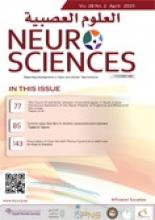ReviewReview Article
Open Access
Common sleep disorders in children: assessment and treatment
Farah Thabet and Brahim Tabarki
Neurosciences Journal April 2023, 28 (2) 85-90; DOI: https://doi.org/10.17712/nsj.2023.2.20220111
Farah Thabet
From the Department of Pediatrics (Thabet), Fattouma Bourguiba University Hospital, Monastir, Tunisia, and from the Department of Pediatric Neurology (Tabarki), Prince Sultan Military Medical City, Riyadh, Kingdom of Saudi Arabia
MDBrahim Tabarki
From the Department of Pediatrics (Thabet), Fattouma Bourguiba University Hospital, Monastir, Tunisia, and from the Department of Pediatric Neurology (Tabarki), Prince Sultan Military Medical City, Riyadh, Kingdom of Saudi Arabia
MD
References
- 1.↵
- Byars KC,
- Yolton K,
- Rausch J,
- Lanphear B,
- Beebe DW. Prevalence
- 2.↵
- Ipsiroglu OS,
- Fatemi A,
- Werner I,
- Tiefenthaler M,
- Urschitz MS,
- Schwarz B.
- 3.↵
- Ogundele MO,
- Yemula C.
- 4.↵
- 5.↵
- Chindamo S,
- Buja A,
- DeBattisti E,
- Terraneo A,
- Marini E,
- Gomez Perez LJ.
- 6.↵
- 7.↵
- Nosetti L,
- Zaffanello M,
- Katz ES,
- Vitali M,
- Agosti M,
- Ferrante G, et al.
- 8.↵
- Elias MF,
- Nicolson NA,
- Bora C,
- Johnston J.
- 9.↵
- Iglowstein I,
- Jenni OG,
- Molinari L,
- Largo RH.
- 10.↵National Sleep Foundation (NSF). How much sleep do we really need? nationalsleepfoundation.org/article/sleep. Accessed August 6, 2022. www.sleepfoundation.org
- 11.↵
- 12.↵
- Bruni O,
- Angriman M.
- 13.↵
- Bruni O,
- Sette S,
- Angriman M,
- Baumgartner E,
- Selvaggini L,
- Belli C, et al.
- 14.↵
- Fernandez-Mendoza J,
- Lenker KP,
- Calhoun SL,
- Qureshi M,
- Ricci A,
- Bourchtein E, et al.
- 15.↵
- 16.↵
- 17.
- Schroder CM,
- Banaschewski T,
- Fuentes J,
- Hill CM,
- Hvolby A,
- Posserud MB, et al.
- 18.↵
- Williams Buckley A,
- Hirtz D,
- Oskoui M,
- Armstrong MJ,
- Batra A,
- Bridgemohan C, et al.
- 19.↵
- 20.↵
- Savini S,
- Ciorba A,
- Bianchini C,
- Stomeo F,
- Corazzi V,
- Vicini C, et al.
- 21.↵
- Marcus CL,
- Brooks LJ,
- Draper KA,
- Gozal D,
- Halbower AC,
- Jones J, et al.
- 22.↵
- 23.↵
- 24.↵
- 25.↵
- Marcus CL,
- Moore RH,
- Rosen CL,
- Giordani B,
- Garetz SL,
- Taylor HG, et al.
- 26.↵
- Lee CF,
- Hsu WC,
- Lee CH,
- Lin MT,
- Kang KT.
- 27.↵
- Rana M,
- August J,
- Levi J,
- Parsi G,
- Motro M,
- DeBassio W.
- 28.↵
- 29.↵
- Zhang F,
- Tian Z,
- Shu Y,
- Zou B,
- Yao H,
- Li S, et al.
- 30.↵
- 31.↵
- Wang YG,
- Benmedjahed K,
- Lambert J,
- Evans CJ,
- Hwang S,
- Black J, et al.
- 32.↵
- 33.↵
- Kim J,
- Lee GH,
- Sung SM,
- Jung DS,
- Pak K.
- 34.↵
- Franceschini C,
- Pizza F,
- Antelmi E,
- Folli MC,
- Plazzi G.
- 35.↵
- Bassetti CLA,
- Kallweit U,
- Vignatelli L,
- Plazzi G,
- Lecendreux M,
- Baldin E, et al.
- 36.↵
- Lecendreux M,
- Plazzi G,
- Dauvilliers Y,
- Rosen CL,
- Ruoff C,
- Black J, et al.
- 37.↵
- DelRosso LM,
- Ferri R.
- 38.↵
- Howard H,
- Kamat D.
- 39.↵
- Prono F,
- Bernardi K,
- Ferri R,
- Bruni O.
- 40.↵
- 41.↵
- Trotti LM,
- Becker LA.
- 42.↵
- Petit D,
- Touchette E,
- Tremblay RE,
- Boivin M,
- Montplaisir J, et al.
- 43.↵
- Bruni O,
- DelRosso LM,
- Melegari MG,
- Ferri R.
- 44.↵
- Panayiotopoulos CP
- Vigevano, F,
- Specchio N.
- 45.↵
- Idir Y,
- Oudiette D,
- Arnulf I. Sleepwalking
- 46.↵
- 47.↵
In this issue
Common sleep disorders in children: assessment and treatment
Farah Thabet, Brahim Tabarki
Neurosciences Journal Apr 2023, 28 (2) 85-90; DOI: 10.17712/nsj.2023.2.20220111
Jump to section
Related Articles
- No related articles found.
Cited By...
- No citing articles found.





